九年级 u8 stonehenge
- 格式:pptx
- 大小:10.63 MB
- 文档页数:17
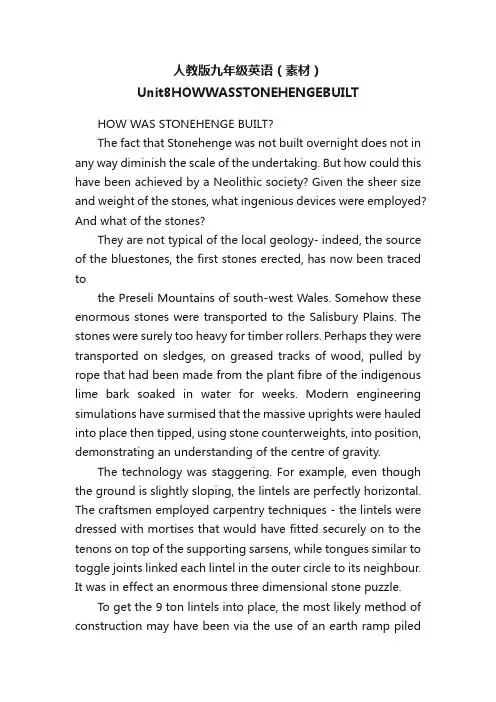
人教版九年级英语(素材)Unit8HOWWASSTONEHENGEBUILTHOW WAS STONEHENGE BUILT?The fact that Stonehenge was not built overnight does not in any way diminish the scale of the undertaking. But how could this have been achieved by a Neolithic society? Given the sheer size and weight of the stones, what ingenious devices were employed? And what of the stones?They are not typical of the local geology- indeed, the source of the bluestones, the first stones erected, has now been traced tothe Preseli Mountains of south-west Wales. Somehow these enormous stones were transported to the Salisbury Plains. The stones were surely too heavy for timber rollers. Perhaps they were transported on sledges, on greased tracks of wood, pulled by rope that had been made from the plant fibre of the indigenous lime bark soaked in water for weeks. Modern engineering simulations have surmised that the massive uprights were hauled into place then tipped, using stone counterweights, into position, demonstrating an understanding of the centre of gravity.The technology was staggering. For example, even though the ground is slightly sloping, the lintels are perfectly horizontal. The craftsmen employed carpentry techniques - the lintels were dressed with mortises that would have fitted securely on to the tenons on top of the supporting sarsens, while tongues similar to toggle joints linked each lintel in the outer circle to its neighbour. It was in effect an enormous three dimensional stone puzzle.To get the 9 ton lintels into place, the most likely method of construction may have been via the use of an earth ramp piledup against the uprights. The lintels would then have been hauled up the ramp by ropes into their exact position.Whatever the methods used, for we are still not certain, they demonstrate an astounding level of both achievement and ambition.WHY WAS STONEHENGE BUILT?As to the purpose of Stonehenge, again we can only surmise. But clearly, the very scale of this unique megalithic structure suggests that the area itself was of importance. But for what?Was Stonehenge a temple to the gods? Who were the gods? It is tempting to assign the giant sarsen stones to astrological alignement. The danger here is that you can find an alignement to almost anything if you search hard enough.But one presents itself immediately - Stonehenge is aligned northeast-southwest, and it has been suggested that particular significance was placed by its builders on the solstice and equinox points, so for example on a midsummer's morning, the sun rose close to the Heel Stone, and the sun's first rays went directly into the centre of the monument between the arms of the horseshoe arrangement. It is unlikely that such an alignment can have been merely accidental.[.Com]Or is this too simple? Turning 180 degrees, another alignment becomes apparent…..at the precise moment of the winter solstice, the sun sets exactly between the largest sarsen stones.To validate this, we must look at the society of the time. It had become a society now dependent on the seasons, which determined the success of agriculture. Would mid-winter have been more important to a society that had now becomedependent upon the fortunes of these seasons? Psychologically, mid-winter would have been more of a critical turning point than the balmy days of summer.Perhaps therefore it is a mistake to overstate the monument’s spiritual significance. Certainly the area had been of importance prior to its construction, but it had become more than that - Stonehenge was a clock, a clock that foretold the time not only ofthe solstices but perhaps also of sun and lunar eclipses. This is not to say, however, that the priests did not utilise this very functionalism for religious importance - he or she who could announce or predict the return of the growing season would have wielded great power.WHEN WAS STONEHENGE BUILT?[.Com]Archaeologists have now been able to establish when the construction ofStonehenge began.Between 3100 and 2800 BC the Great Cursus 300 yards from Stonehenge had been constructed - nearly one and a half miles long and 150 yards wide, on an east-west alignment. This was a ditch hewn in the chalk 6 feet deep and wide, and would have appeared brilliant white in the green of what had now become pastureland. Was this used for chariot racing by the ancient Britains, from 'cursus', the Latin term for race course? Or was it a processional way, a path for the dead? The placing of burial mounds, known as the Cursus Barrows, on their edges may support this view.Around 2700 BC, the henge was constructed. Using only picks made of deer antlers, a ditch about 6 feet deep was dug. The spoil from the ditch was used to make the bank on the inside. On the north-east of the henge, an entrance was created by agap in the ditch and bank. Within the bank, a circle of fifty six pits known as the Aubrey holes were dug.Over the next 200 years, between 2700 and 2500 BC, a large number of wooden posts were erected. The ones at the north-eastern entrance may have served as markers for astronomical measurements, in particular the extremes of the moonrise and moonset. Other scholars feel these may have guided people through narrow paths to the ceremonial centre, adding a mystique to the entry. When looked at from the centre of the monument, we can see that the entrance stakes line up - these small posts are six rows deep. The four larger posts furthest away are located in what was later to become the Avenue leading to the north-east. They were perhaps 1m in diameter, possibly whole tree trunks.From about 2500 BC onwards, the first stones arrived. The bluestones were erected and the Avenue, a grand-scale earthwork monument sweeping nearly 2 miles from the River Avon to the north-eastern。
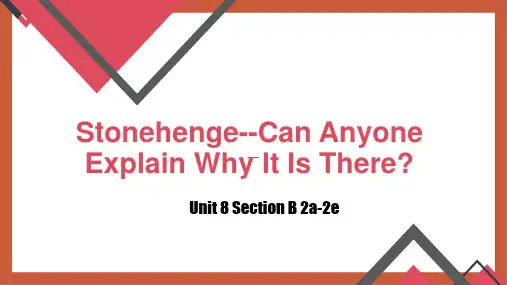

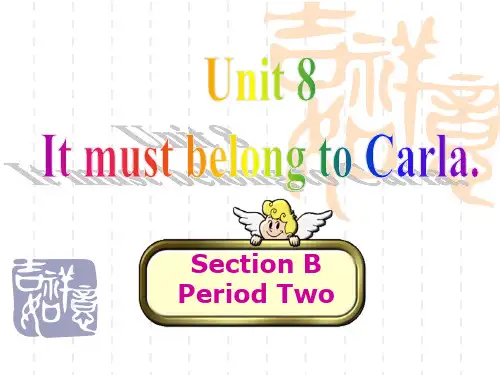
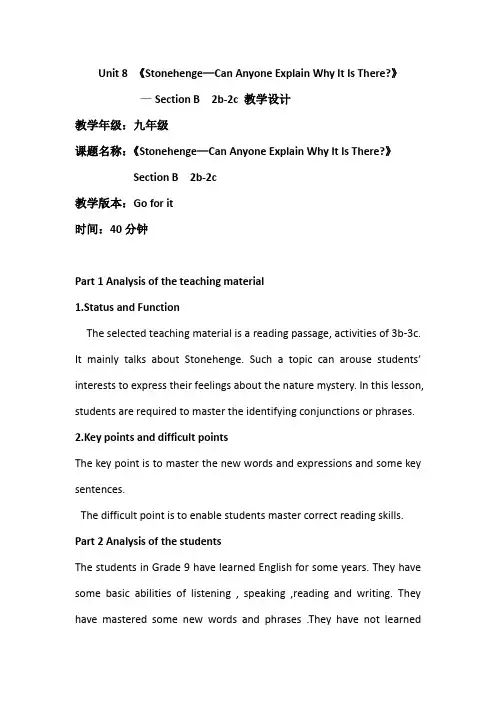
Unit 8 《Stonehenge—Can Anyone Explain Why It Is There?》—Section B 2b-2c 教学设计教学年级:九年级课题名称:《Stonehenge—Can Anyone Explain Why It Is There?》Section B 2b-2c教学版本:Go for it时间:40分钟Part 1 Analysis of the teaching material1.Status and FunctionThe selected teaching material is a reading passage, activities of 3b-3c. It mainly talks about Stonehenge. Such a topic can arouse students’ interests to express their feelings about the nature mystery. In this lesson, students are required to master the identifying conjunctions or phrases.2.Key points and difficult pointsThe key point is to master the new words and expressions and some key sentences.The difficult point is to enable students master correct reading skills. Part 2 Analysis of the studentsThe students in Grade 9 have learned English for some years. They have some basic abilities of listening , speaking ,reading and writing. They have mastered some new words and phrases .They have not learnedsome information about Stonehenge before. It will be a little difficult for them to learn the passage. So I will pay more attention to those who have difficulties in English study.Part 3 Analysis of the teaching aimsAccording to the new curriculum standard, I hope I can achieve the following aims in this class.1).Language aimsAfter the class, Students will master the basic meaning of the new vocabulary. They will know some basic knowledge about Stonehenge. 2).Ability aimsBy the end of this lesson , the students will improve the students’ reading skills.3).Emotional aims:Teach students that we should enjoy the beauty of our world.Part 4 .Analysis of teaching methods and teaching model1.Teaching methodsStudents are the real masters in class while the teacher acts as a director and in order to achieve my goal, I will use the following teaching methods.1.Task-based teaching and learning: I can design several tasks to allow the students to finish the learning task.2.Cooperative learning. Through group work, students can learn how tocooperate well with the others.municative teaching method.2.Teaching aidsIn order to practice my teaching methods better ,I will make good use of the multimedia. It’s more vivid and clear to use multimedia.3.Teaching modelI use the student-centered teaching model in this class .The students should be seen as the center of the class. It can enable learners to learn the lesson more actively and efficiently.Part 5 Teaching procedureAccording to the teaching aims, I will divide the teaching procedures into 6 steps.Step 1:Revision(1).Review the language goal of making inferences.Eg: Whose money is this?Whose mobile phone is this?It could/might be________.It must be_______.It can’t be _______.Step 2 Pre-reading1) Show the students the new words and expressions and ask them to recite the new words one by one.2) Show the picture in this page and the title of the passage to the students and ask them to predict what the passage mainly talk about. Purpose: Check if the students have read the new words and expressions and cultivate their ability to predict.Step3 While-readingPurpose : to enable students to understand the given material better by using different reading skills.1.Fast reading(3a)Read and match the main idea with each paragraph.Para. 1What is it?Para. 2 Who built it?Para. 3What is it?Para. 4What is it used for?2.Intensive reading.1. Read the first and the second paragraph carefully and fill in the blanks. It is a rock circle.It receives more than 750,000 visitors.It is in Britain.They want to see the sun rising on the longest day of the year.2.Read the second paragraph and then fill in the blanks.3.Read the third paragraph and finish the sentences.1. Stonehenge might be ________________.2. Other people believe the stones have _________________.3. Most people agree that the position of the stones must be for _________________. Some think it might be ____________ or a place to ________________. Others think it was built to __________________.4.Read the last paragraph and fill in the blanks.Stonehenge was built slowly over a long period of time. Most historians believe it _______ almost 5000 years old. One of the greatest mysteries is ______________ because the stones are so big and heavy. Paul says, “We don’t really know who built Stonehenge, and perhaps we ______ never know, but we do know they ____________ hard-working—and great planners.”Step 4 Post-readingThe purpose of the step is to give students practice in using the target language.1.Read the article and underline the linking words and phrases.2.Read the article and complete the chart in 2c.plete the sentences with the correct linking words.Task 3 Discussion. Ask the students to discuss the questions with three or four partners.Can you think of any other mysteries, either in China or another part of the world, that are similar to Stonehenge?What do you know about these mysteries?What is mysterious about them?Discuss them with your group.Step 5 SummaryPurpose:This activity will help students to summarize the target language .I will ask the students to sum-up the knowledge that is learned in this class together with me.Step 6 HomeworkPurpose:This activity will help students to consolidate the target language we have learned today. From their homework, I will find out what the students have mastered and what they haven’t .1. Review the new words and expressions you’ve learned today.2. Read the articles in Learning English.3. Preview the new words and expressions.4. Preview 3a-3b on P63-64.Part 6 Blackboard DesignStonehenge—Can Anyone Explain Why It Is There?—Section B 2b-2cStonehenge1.a rock circle2.in Britain3.a temple4.a kind of canlendar5.a medical purpose6.a burial place7.celebrate a victory。

STONEHENGECan you explain why itis there, Miss Frizzle?Miss FrizzleI know little about it, either. Let’s take the magic bus to visit Stonehenge and find out the answer together, ok?Stonehenge-can anyone explain why it is there?Stonehenge, a rock circle, is not only one of Britain’s most famous historical places but also one of its greatest mysteries. Every year it receives more than 750,000 visitors. People like to go to this place especially in June as they want to see the sun rising on the longest day of the year.For many years, historians believed Stonehenge was a temple where ancient leaders tried to communicate with the gods. However,historian Paul Stoker thinks this can’t be true because Stonehenge was built so many centuries ago. “The leaders arrived in England much later,” he points out.Another popular idea is that Stonehenge might be a kind of calendar. The large stones were put together in a certain way. On midsummer’s morning, the sun shines directly into the center of the stones. Other people believe the stones have a medical purpose. They think the stones can prevent illness and keep people healthy. “As you walk there, you can feel the energy from your feet move up your body,” said one visitor. No one is sure what Stonehenge was used for, but most agree that the position of the stones must be for a special purpose. Some think it might be a burial place or a place to honor ancestors. Others think it was built to celebrate a victory over an enemy.Stonehenge was built slowly over a long period of time. Most historians believe it must be almost 5,000 years old. One of the greatest mysteries is how it was built because the stones are so big and heavy. In 2001, a group of English volunteers tried to build another Stonehenge, but they couldn’t. “We don’t really know who built Stonehenge,”says Paul Stoker. “And perhaps we might never know, but we do know they must have been hard-working —and great planners!”The First Step of The Trip (Paragraph 1)Boys and girls, what do you think of stonehengeNotes:It is not only _________________________________but also ______________________________ It receives more than __________MysteriesA famous placeNotes:People like to go there in______ as they want to see____________________________________When do people like to go to this place and why?The Second Step of The Trip (Paragraphs 2&3)The Third Step of The Trip (Paragraphs 4)Who built the stonehenge? How was it built?Nobody exactly knows.It might be aliens or somebody else. Let’s go. The bus is coming.Mysteries about StonehengeYou opinions about WHO&HOWNobody knows but I think It might be built by__________ because ______ _____________________________________________________________. TheymightbuilditbyExercise from Miss FrizzleStonehenge is __________ a famous historical place ___________ a great mystery. people like to go there in June __________ they want to see the sun rising on the longest day of the year.Historians believed it was a temple used by ancient leaders. ____________, historian Paul stoker thinks that can't be true ____________ it was built so many years ago. Others believe it might be a kind of calendar _______ have a medical purpose. No one is sure what Stonehenge was used for _________ most agree that it must be for a special purpose. It might be a burial place_______ a place to honor ancestors. Others think it was built to celebrate a victory over an enemy.One of the mysteries is how it was built _________ the stones are so big and heavy. Someone tried to build another Stonehenge _________ they couldn't. Wemight never know, __________ we do know they must have been hard-working and great planners.rwhoMysteryhowwhat...forwhen...Part 1: The introduction of ..... It's not only...but also...People like to go there as/ since/because ... Part 2: The mysteries about...。

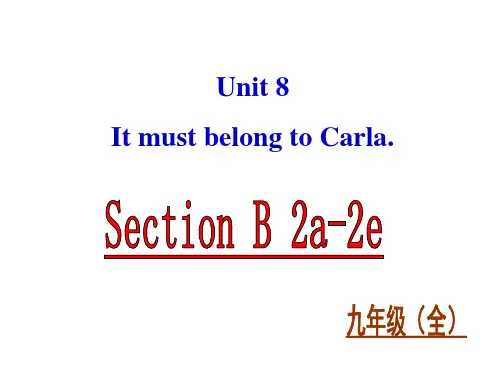
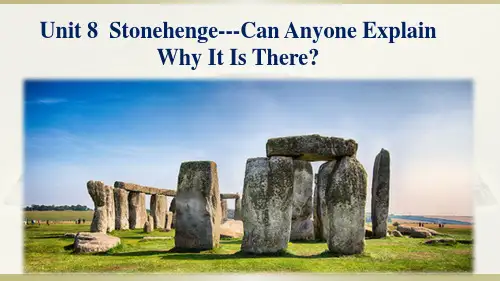
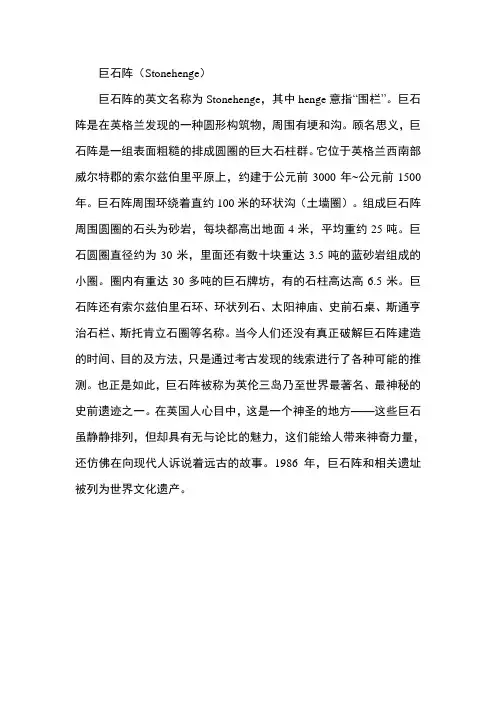
巨石阵(Stonehenge)
巨石阵的英文名称为Stonehenge,其中henge意指“围栏”。
巨石阵是在英格兰发现的一种圆形构筑物,周围有埂和沟。
顾名思义,巨石阵是一组表面粗糙的排成圆圈的巨大石柱群。
它位于英格兰西南部威尔特郡的索尔兹伯里平原上,约建于公元前3000年~公元前1500年。
巨石阵周围环绕着直约100米的环状沟(土墙圈)。
组成巨石阵周围圆圈的石头为砂岩,每块都高出地面4米,平均重约25吨。
巨石圆圈直径约为30米,里面还有数十块重达3.5吨的蓝砂岩组成的小圈。
圈内有重达30多吨的巨石牌坊,有的石柱高达高6.5米。
巨石阵还有索尔兹伯里石环、环状列石、太阳神庙、史前石桌、斯通亨治石栏、斯托肯立石圈等名称。
当今人们还没有真正破解巨石阵建造的时间、目的及方法,只是通过考古发现的线索进行了各种可能的推测。
也正是如此,巨石阵被称为英伦三岛乃至世界最著名、最神秘的史前遗迹之一。
在英国人心目中,这是一个神圣的地方——这些巨石虽静静排列,但却具有无与论比的魅力,这们能给人带来神奇力量,还仿佛在向现代人诉说着远古的故事。
1986年,巨石阵和相关遗址被列为世界文化遗产。
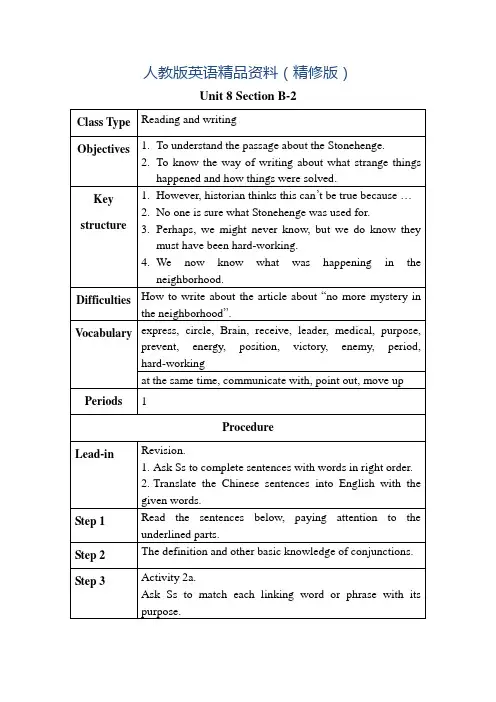
人教版英语精品资料(精修版)Unit 8 Section B-2Class Type Reading and writingObjectives 1.To understand the passage about the Stonehenge.2.To know the way of writing about what strange thingshappened and how things were solved.Key structure 1.However, historian thinks this can’t be true because …2.No one is sure what Stonehenge was used for.3.Perhaps, we might never know, but we do know theymust have been hard-working.4.We now know what was happening in theneighborhood.Difficulties How to write about the article about “no more mystery in the neighborhood”.Vocabulary express, circle, Brain, receive, leader, medical, purpose, prevent, energy, position, victory, enemy, period,hard-workingat the same time, communicate with, point out, move up Periods 1ProcedureLead-in Revision.1.Ask Ss to complete sentences with words in right order.2.Translate the Chinese sentences into English with thegiven words.Step 1 Read the sentences below, paying attention to the underlined parts.Step 2 The definition and other basic knowledge of conjunctions. Step 3 Activity 2a.Ask Ss to match each linking word or phrase with itspurpose.Step 4 Free talk.1.Have you ever heard of Stonehenge?2.Where is it?3.Why is it famous?Step 5 Brainstorm.Read a video about the huge stone and then give someinformation about it.Step 6 Activity 2b.Skim the article and underline the sentences with linkingwords or phrases.Step 7 Read again and ask Ss to answer the questions.Step 8 Activity 2c.Read the article again and complete the chart.Step 9 Activity 2d.Ask Ss to complete the sentences using the words from thechart in 2a.Step 10 Brainstorm.1.Introduce Ss about interesting and fun Stonehenge factsfor kids.2.Introduce some buildings with mysterious origins.Step 11 Language points: explain the key words and phrases in section B-2.Step 12 More exercises about the language points.。
人教版九年级上册U n i t8S t o n e h e n g e 巨石阵原文+翻译Stonehenge——Can anyone explain why it is there?Stonehenge, a rock circle, is not only one of Britain’s most famous historical places but also one of its greatest mysteries. Every year it receives more than 750,000 visitors. People like to go to this place especially in June as they want to see the sun rising on the longest day of the year.巨石阵,一个岩石圈,不仅是英国最著名的历史建筑,也是它的一个最大的谜团之一。
每年接待超过七十五万游客。
特别是在6月,人们去这个地方,因为他们想看到太阳上升在一年中最长的一天。
For many years, historians believed Stonehenge was a temple where ancient leader tried to communicate with the gods. However, historian Paul Stoker thinks this can’t be true because Stonehenge was built so many centuries ago. “The leaders arrived in England much later, ”he points out.许多年以来,历史学家们认为巨石阵是古代首领用来与神灵沟通的一座神庙。
然而,历史学家保罗·斯托克认为这不可能是真的,因为建造了巨石阵很多世纪以前。
While-reading:Task 1: Skim the passage and then answer the questions below.1. Where is Stonehenge?2. Who built Stonehenge?Task 2: Read and match the main idea with each paragraph.Task 3: 见课本62页Activity 2b 。
Task 4: Read the first paragraph and then answer the following questions.1. What’s Stonehenge?2. Why do people visit Stonehenge in June?Task 5: Read the second paragraph and then fill in the blanks. Para. 1 Para. 2 Para. 3 Para. 41. Who built Stonehenge, when it was built and how it wasbuilt are still mysteries.2. Historians have different ideas about what Stonehengewas built for.3. Stonehenge is not only a famous historical place, butalso a great mystery.4. Different ideas about the purpose of Stonehenge.Historians Historian Paul StokerOpinions believed Stonehenge was a_______ where ancientleaders tried to_______________ the gods•thinks _______________because _____________________________•points out the leadersarrived in England____________Task 6: Read the third paragraph and finish the sentences.1. Stonehenge might be ________________.2. Other people believe the stones have _________________.3. Most people agree that the position of the stones must be for _________________. Some think it might be ____________ or a place to ________________. Others think it was built to __________________. Task 7: Read the last paragraph and fill in the blanks.Stonehenge was built slowly over a long period of time. Most historians believe it _______ almost 5000 years old. One of the greatest mysteries is ______________ because the stones are so big and heavy. Paul says, “W e don’t really know who built Stonehenge, and perhaps we ______ never know, but we do know they ____________ hard-working—and great planners.”Task 8: 见课本63页Activity 2c。